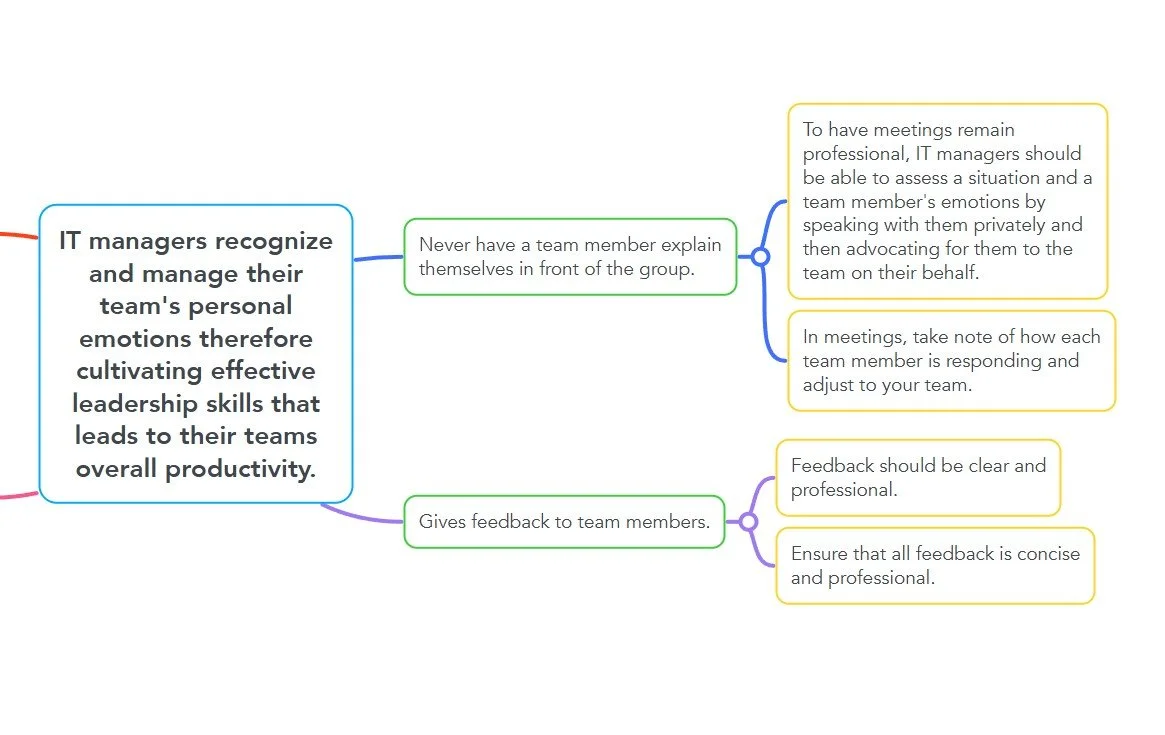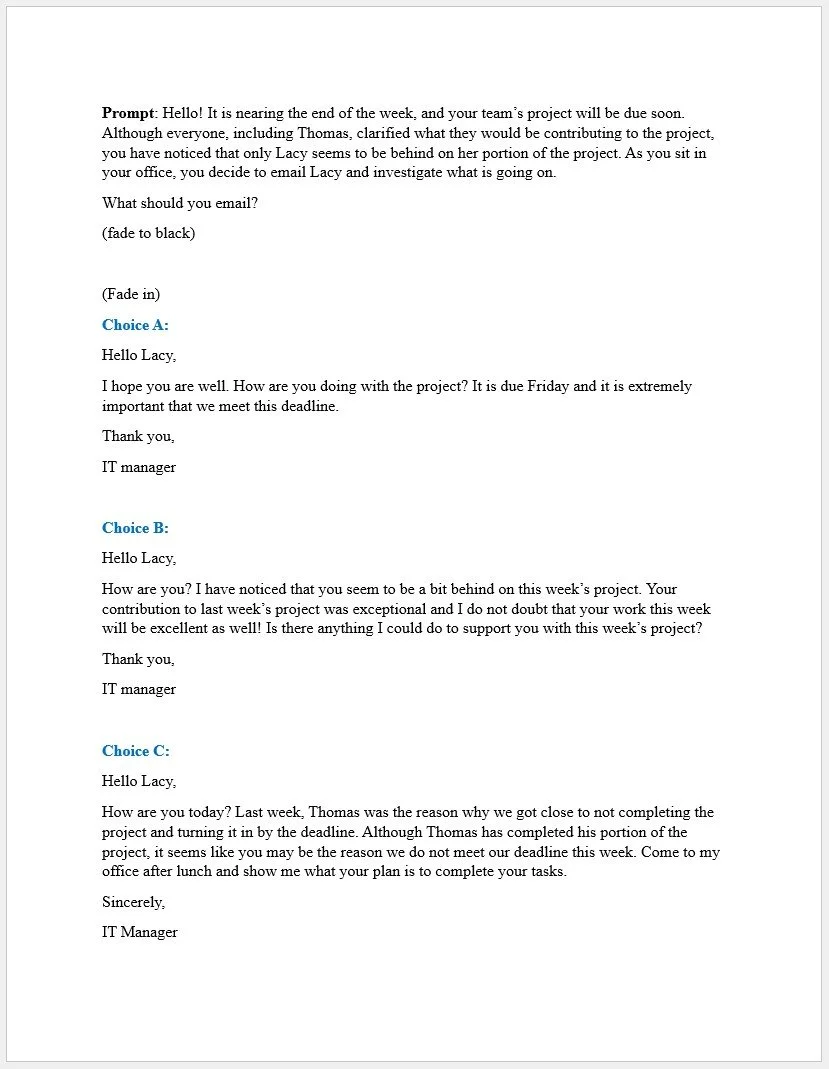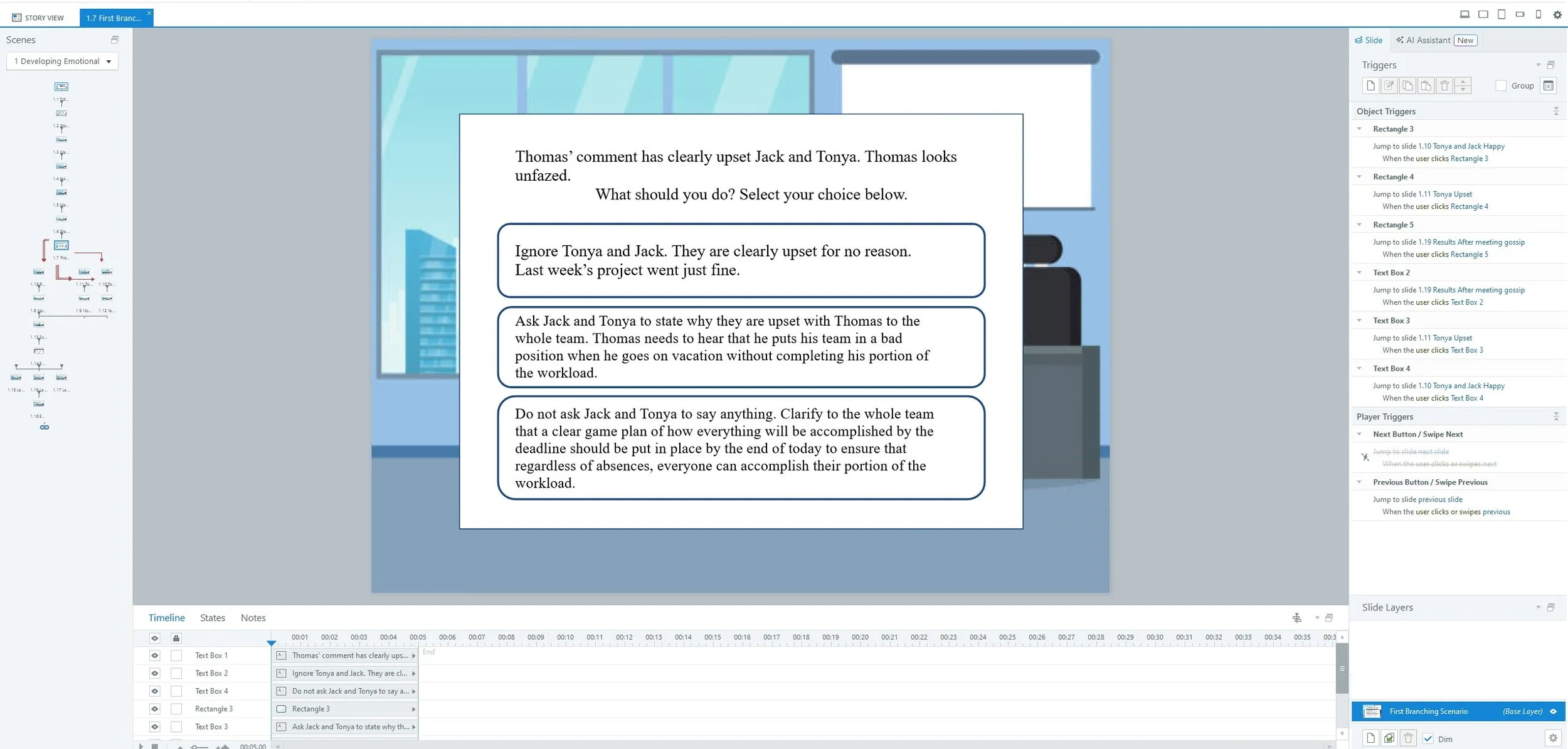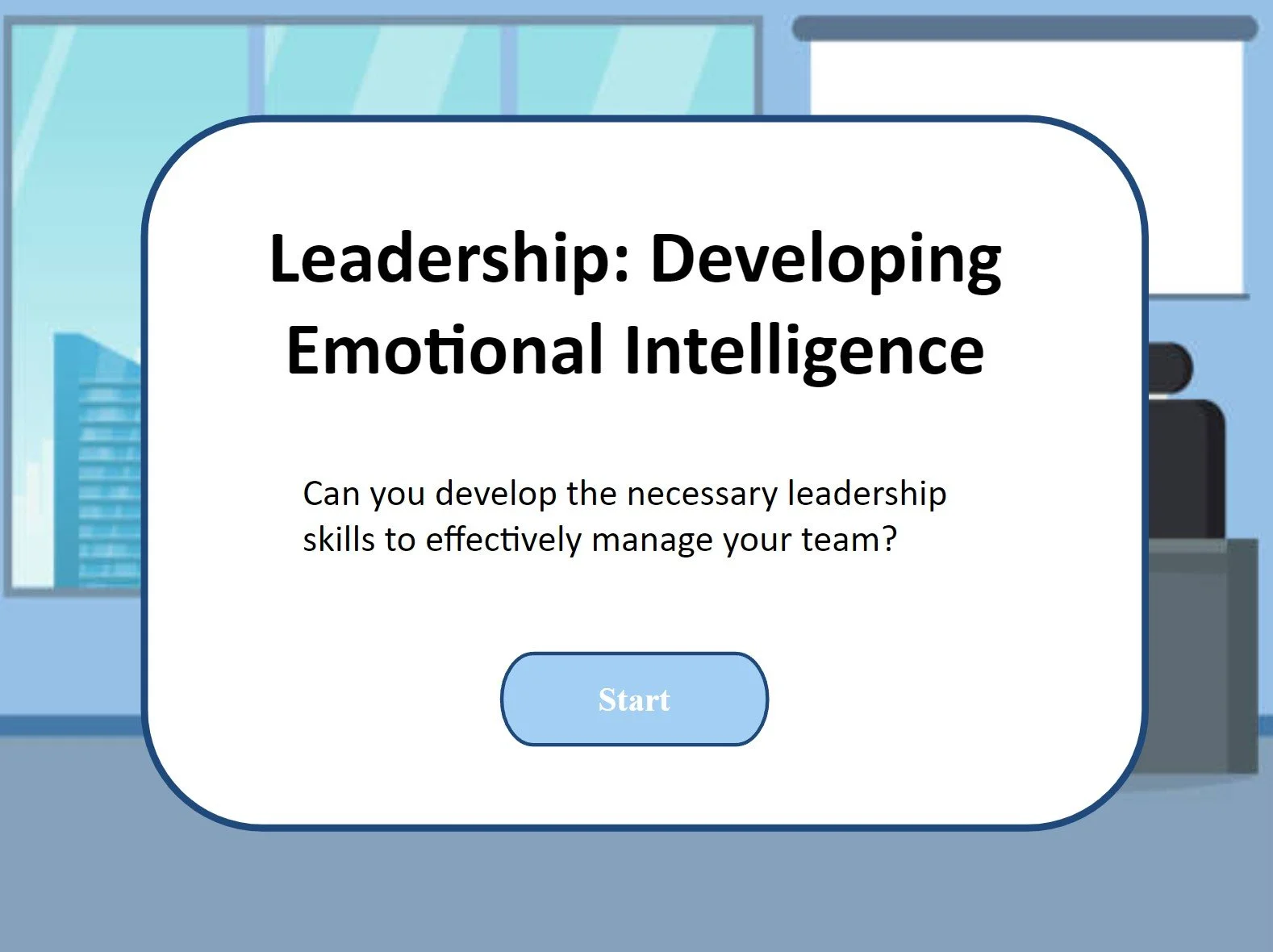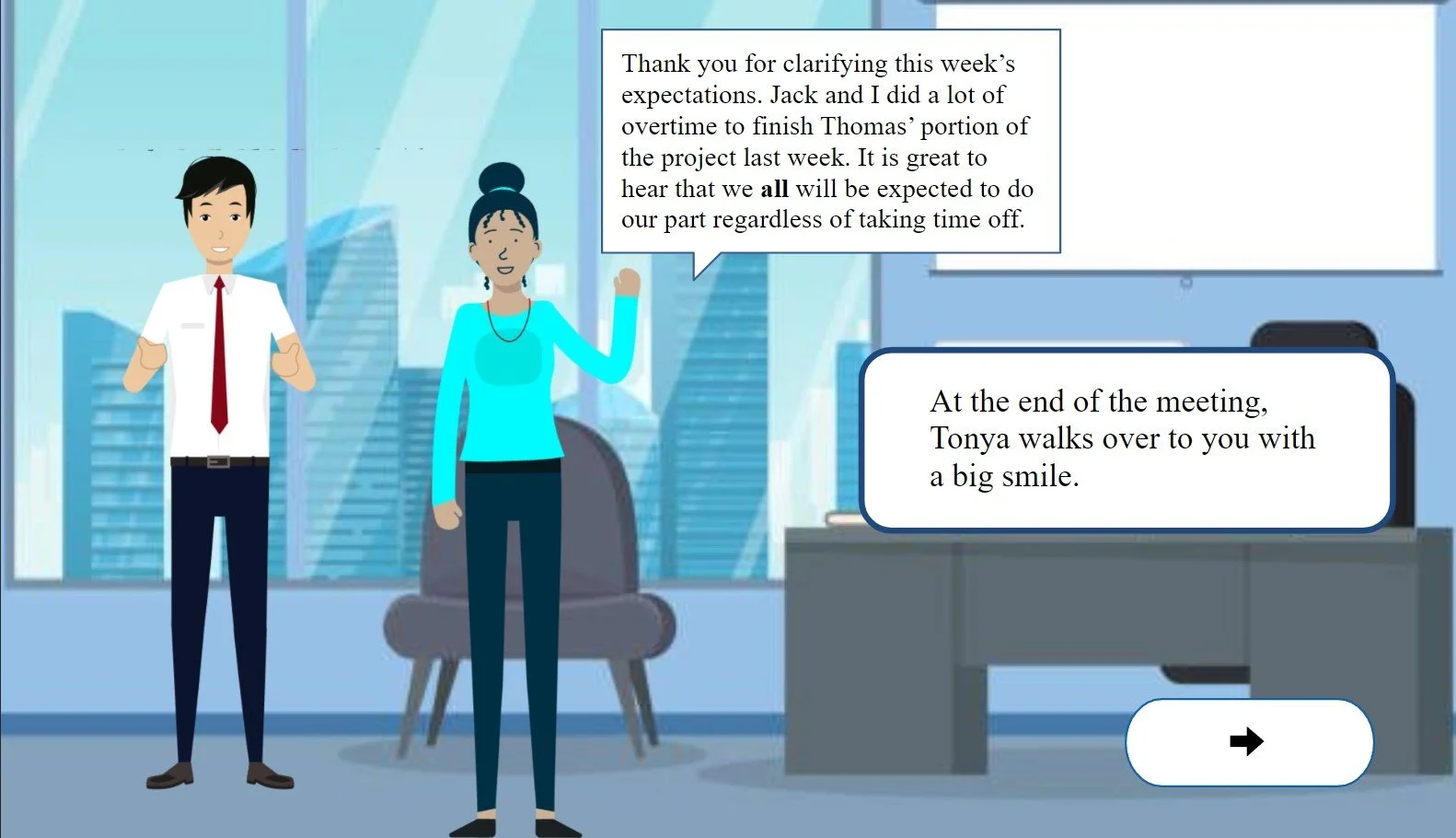Leadership: Developing Emotional Intelligence
Can you develop the necessary leadership skills to effectively manage your team?
Overview
Audience:
Mid-level information technology managers who oversee five to eight employees and have been in or just starting a managerial role.
Responsibilities:
· Instructional Design
· eLearning Development
· Gamified Design
· Branching Scenario Design
· Visual Design
· Prototype Creation
Tools Used:
· Articulate Storyline
· Microsoft Windows
· MindMeister
· Visme
The Problem
A mid-sized IT firm required effective emotional intelligence leadership training for newly promoted and newly hired IT managers. The previous mandated training was informal, inconsistent, and underdeveloped.
This lack of effective training led the IT managers to create their own standard of communication with their team members. Via their lack of formal training, managers were deemed unprepared to manage and effectively respond to their team members’ personal emotions.
We discovered that many of the IT managers lacked empathy towards their team members and that team members were left feeling unheard and even disrespected by their IT managers.
The Solution
We decided to focus on a leadership learning experience that solely focused on the development of emotional intelligence in the workplace. All IT managers would be required to interact with the learning experience and develop skill sets that would help them recognize, manage, understand, and respond to their teams’ emotions while demonstrating empathy. In doing so, the IT managers would be cultivating a safe, well-structured, and productive working environment.
I proposed that the learning experience should include gamified and game-based learning components to ensure learners are motivated and well-informed while engaging with the learning experience. To do so, the learning experience would include branching scenarios that encourage the user.
The Process
I began the process by discussing with the Subject Matter Expert (SME) the overall objectives and outcomes of the learning experience. I then used the ADDIE model and Gagne’s Nine Events of Instruction to clearly define the learning objectives. The SME and I were able to establish prior knowledge the IT managers had on the subject, clarify ways to gain the attention of the learners via the experience, and ensure a path that would lead to an effective learning experience for the IT managers. We then created an action map to effectively lay out the expectations previously discussed. After deciding on the top actions the learners should perform, I designed the text-based storyboard. Upon approval from the SME, I created the visual mockups. Using both the text-based storyboard and visual mockups, I then designed the visual storyboard which included the programming notes.
The overall experience would gain the attention of the learners by utilizing animation, simple action requests, and incorporating immediate job-relevant scenarios. In doing so, the learning experience would focus on a problem and solution format ensuring that every learner gained the necessary skill sets to be an emotionally intelligent leader.
I designed an interactive prototype in Articulate Storyline. I then received the necessary prototype feedback from the SME. Once the feedback was incorporated into the design, I developed the final learning experience.
Gagne’s Nine Events of Instruction Learning Experience Outline
Action Map
I designed an action map with the SME to clarify the necessary actions the learner would need to perform to complete the goal. Once the SME and I identified that the IT managers required emotional intelligence development across the board, we were able to work together and establish scenarios dependent on the recognizing and validating of their teams' emotions. Via the information gathered, I was able to design an action map that highlighted the two most effective and engaging actions learners could take to develop emotionally intelligent leadership skills.
Learning Experience Action Map
Text-Based Storyboard
Once I completed the action map, the SME and I worked to create a text-based storyboard. Each scenario was based on the overall solutions the SME and I hoped to have the learners accomplish. We made sure to create scenarios that were relevant to the learners' everyday work tasks and expectations to ensure a “real-world” effect.
Each scenario would have a confirmatory or remedial response given by the learning coach. Feedback would therefore be given immediately after the learner picked an action.
Learning Experience Text-Based Storyboard
Visual Mock-ups/Visual Storyboard
As soon as the SME approved the text-based storyboard, I designed the visual mood/mock-ups for the project. After doing so, I incorporated any and all feedback into the design. My goal for the design was to create animations within a simplistic and easy-to-view environment. Research has proven that workplace training and simulations are much easier for the learner to engage with when the characters are animated. Research has also shown that simplistic designs are easier to digest and remember than complex designs. These were the motivations behind my design.
I then moved on to my visual storyboard. The visual storyboard was a combination of the text-based storyboard and the visual mock-ups. The visual storyboard also included the programming and animation notes to ensure complete transparency for the SME. I made sure to receive and incorporate necessary feedback from the SME and my peers during this step as well.
Learning Experience Visual Storyboard
Interactive Prototype/Full Development
In Articulate Storyline, I created an interactive prototype for the first branching scenario. I made sure to review and incorporate the SME and my peers' feedback. I used the interactive prototype to refine the rest of the project, making sure to rectify the sequences and animations throughout. I allowed my peers and a few IT managers to act as test users. I incorporated their feedback to ensure that the design functioned properly.
Via the structured process, I designed the rest of the scenarios in the project on Articulate Storyline. I made sure to include a serious game/game-based learning principle. The principle clarifies that learning experience designers should create challenging scenarios in safe environments. I designed scenarios that could happen in real life but if the learner makes a mistake they can learn from their mistake without enduring real-world consequences. This design therefore creates a motivating and effective learning experience. Via the previous steps taken, the development of the final design was precise and quick to execute.
Interactive Prototype
Full Development
Results and Takeaways
Chi worked extremely well with our Subject Matter Expert. The two of them were able to create a product that our firm will use for many years to come.
I enjoyed working with Ms. Chinyere! Every time I had a note or a perspective to incorporate into her design she was all ears. She always listened and adapted to feedback well.
After doing this training, I feel more confident as a leader and as a professional.








